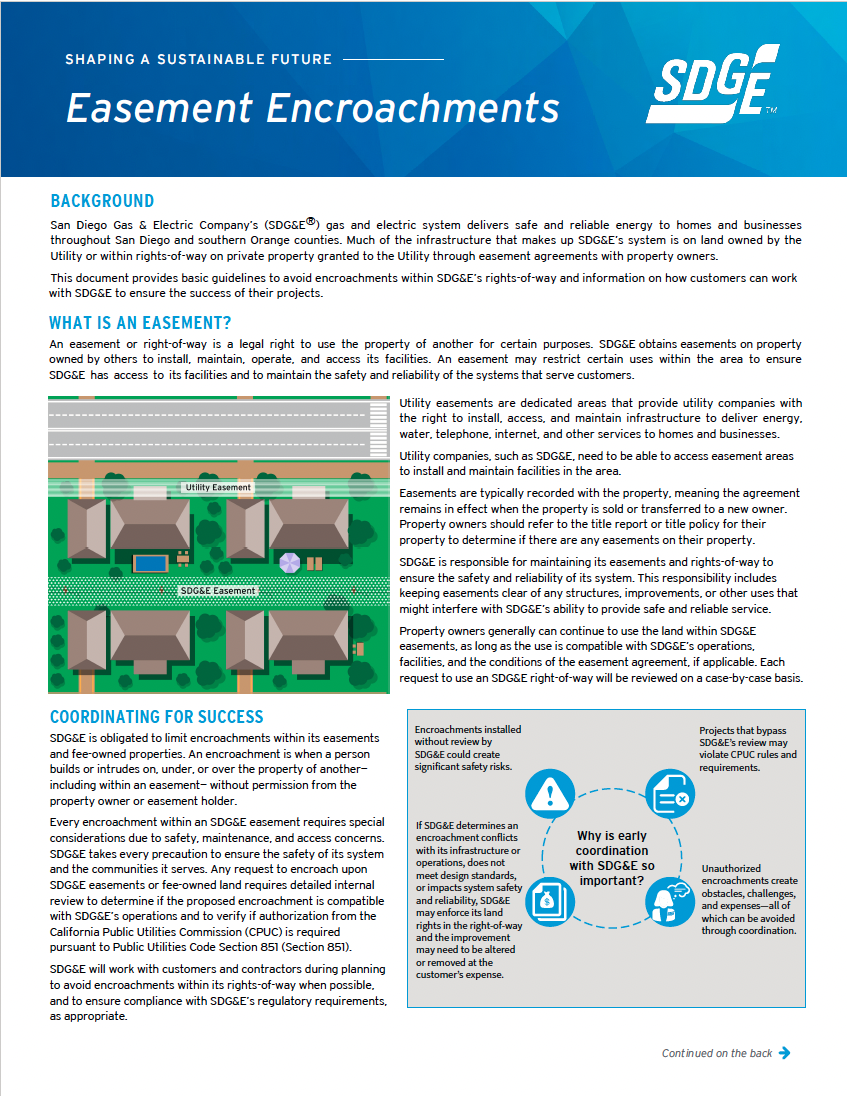Encroachment Requests
Private land owners, developers, or public agencies must contact SDG&E even if they have an approved permit from the city or county. Failure to obtain prior approval could result in the removal of the encroachment at the land owner’s expense. Please refer to CPUC laws, regulations and policies, that may affect your project feasibility and timeline, on the Land Services main page.


Encroachments Fact Sheet
Learn more about easement encroachments and how you can work with SDG&E to ensure the success of your projects by viewing the Encroachments Fact Sheet.
Types of encroachments and activities typically denied:
- Buildings, homes, porches, additions and decks
- Stored trailers, recreational vehicles and inoperable vehicles
- Swimming pools located above and below ground
- Retention ponds
- Fuel storage facilities, above ground or below grade
- Billboards
- Fences that deny SDG&E access to the easement corridor
- Uses of easement area for fill dirt or other refuse
- Lights, flag poles and antennas
- Swing sets, slides and climbing equipment
- Certain types of trees and other vegetation
- Fire hydrants
- Retaining walls
- Flammable or combustible materials
- Excavating near utility poles, towers and other facilities
- Changing the ground elevation
- Operating machinery in a manner that has the potential to contact or damage SDG&E facilities
If your project design encroaches into an SDG&E property, easement or right-of-way, SDG&E may request you to redesign your project, or potentially not approve your encroachment request. If you would like to proceed, please refer to the land encroachment review process below and the required documents to be submitted to SDG&E Builder Services or the Service Order Team. SDG&E cannot begin internal review of your project without the required documents. Once your completed forms and required documents are received, SDG&E will begin an internal review.
Easements and Rights-of-Way Encroachment Request Process
To have SDG&E review your proposed use of our easements or rights-of-way please follow the process below. SDG&E does not issue verbal consents and any claim of a verbal consent will not be honored.
Document Submission
- Complete our online Encroachment Request form below.
- Submit completed request form and all of the following applicable documents to the Land Services department at [email protected].
Documents List
- Title Report
-
All available plans (Grading, Improvement/Site, Landscape, and Irrigation)
- Map or plan illustrating the easement location and any existing or proposed SDG&E facilities
- Any other relevant documents that pertain to your request
- Completed Encroachment Request form
Frequently Asked Questions
An easement or right-of-way is a right to use the property of another for certain purposes. SDG&E obtains easements on property, owned by others, for the right to install, maintain, operate and access our facilities on that property. The easement may restrict certain uses within the easement or right-of-way area, for the purpose of maintaining unencumbered access to SDG&E facilities, allowing us to maintain safe and reliable systems. An easement or right-of-way remains in effect and transfers with the property to any new owners.
An SDG&E utility corridor is a strip of land that forms a passageway through which SDG&E installs, operates and maintains its gas and electric facilities both above and below ground. An SDG&E utility corridor can either be located within land owned by SDG&E, or within land owned by another upon which SDG&E has an easement or right-of-way.
An encroachment occurs when a person builds on or intrudes on, under, or over the property of another, including within an easement, without permission from the property or easement holder.
Property owners should refer to their property title report or title policy to determine the presence of any easements on their property.
Any item or activity that could interfere with the safe and reliable operation of SDG&E’s facilities is called an encroachment, which is prohibited under the terms of the easement along with any prohibited encroachments by City, State, and Federal policies. SDG&E actively enforces rights granted by our easements, and protected by these government policies, to ensure reliable operation of our electric and gas systems.
The Owner of the property has the responsibility to maintain clearance of all encroachments from an SDG&E easement, which can include clearing of vegetation, trash, or any other materials that interfere with SDG&E facilities. SDG&E’s easements give us the right, but not the obligation, to trim trees and remove vegetation as needed. SDG&E may choose to enforce its easement rights to require such clearing at the property owner’s expense.
SDG&E has the right to use an easement or right-of-way for specific purposes including access to and from its gas and electric facilities for maintenance and construction. SDG&E may enforce these rights and rights granted through government policies, by requiring the encroachment be removed at the property owner’s expense.
At SDG&E, we take great care to keep our facilities clear of anything that might cause a safety or reliability issue. Uses within an SDG&E easement or right-of-way are usually very limited in scope and type. Uses of any type require written consent from SDG&E along with adherence to all California Public Utilities Commission (CPUC) General Orders and OSHA standards. Certain encroachments may require approval from the CPUC. If you have an existing project number from SDG&E Builder Services or Service Order Team, you can submit an Encroachment Request for SDG&E to review.
If you have an easement maintenance concern, please email SDG&E Land Services Department at [email protected].
Contact Information
For questions regarding an SDG&E easement or right-of-way
Email the Land Services Department at [email protected] if you have questions regarding a SDG&E easement or right-of-way.
For general inquiries, NOT related to lands rights, contact SDG&E Customer Service at 1-800-411-7343
For inquiries regarding vegetation management
Visit our Vegetation Management pages.
Email Vegetation Management at [email protected] or Call (858) 654–8608
Call 811 Before You Dig
Please call 811 for Dig Alert before you dig. DigAlert must be called at least 2 working days in advance of digging but no more than 14 days before digging is to start. If digging is not complete within 28 days of mark out, then DigAlert must be called to mark out again. Mark out must be redone every 28 days until excavation (digging) is completed. Mark out is provided free for the first mark out. SDG&E will send a crew to mark the underground gas and electric facilities before you begin work, helping you to plan a safe project. For detailed DigAlert information go to https://digalert.org/calaw-full.